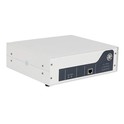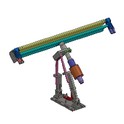In the realm of industrial cleaning and filtration, ultrasonic tank filters play a pivotal role. As a long - standing supplier of ultrasonic tank filters, I've witnessed firsthand the evolution of this technology. In this blog, we'll explore whether there are new technologies in ultrasonic tank filter design.
Traditional Ultrasonic Tank Filter Design
Before delving into the new technologies, it's essential to understand the traditional design of ultrasonic tank filters. A typical ultrasonic tank filter consists of a tank where the cleaning solution is stored, an ultrasonic generator that produces high - frequency sound waves, and a filtration system. The ultrasonic waves create cavitation bubbles in the cleaning solution. These bubbles implode near the surface of the objects being cleaned, dislodging dirt and contaminants. The filtration system then removes the debris from the solution, ensuring the cleaning solution remains effective.
The filtration part usually involves mechanical filters such as mesh screens or cartridge filters. These filters trap particles of different sizes based on their pore size. However, traditional mechanical filters have limitations. Over time, they can become clogged, reducing the flow rate of the cleaning solution and the efficiency of the entire system. Additionally, they may not be effective in removing very fine particles or certain types of contaminants.
New Technologies in Ultrasonic Tank Filter Design
Advanced Filtration Media
One of the significant advancements in ultrasonic tank filter design is the use of advanced filtration media. Nanofiber filters, for example, have emerged as a game - changer. These filters are made of extremely fine fibers with diameters in the nanometer range. The small fiber diameter creates a large surface area for filtration, allowing for high - efficiency particle capture. Nanofiber filters can trap particles as small as a few nanometers, which is far beyond the capabilities of traditional mechanical filters.
Another type of advanced filtration media is activated carbon - based filters. Activated carbon has a large surface area with numerous pores. It can adsorb a wide range of contaminants, including organic compounds, odors, and some heavy metals. When incorporated into an ultrasonic tank filter, activated carbon filters can enhance the overall cleaning quality by removing not only solid particles but also dissolved contaminants in the cleaning solution.
Smart Monitoring and Control Systems
Modern ultrasonic tank filters are increasingly being equipped with smart monitoring and control systems. These systems use sensors to continuously monitor various parameters such as the flow rate of the cleaning solution, the pressure within the filter, the temperature of the solution, and the level of contaminants in the solution.
The data collected by these sensors is then analyzed by a control unit. If the flow rate drops below a certain threshold, indicating a clogged filter, the system can automatically adjust the flow or send an alert to the operator. Similarly, if the contaminant level in the solution exceeds a preset limit, the system can initiate a back - flushing process or suggest changing the filter media. This real - time monitoring and control improve the efficiency of the filter and reduce the risk of system failures.
Integration of Ultrasonic Technology with Other Cleaning Methods
In recent years, there has been a trend of integrating ultrasonic technology with other cleaning methods in tank filter design. For example, some ultrasonic tank filters now combine ultrasonic cleaning with electro - chemical cleaning. Electro - chemical cleaning uses an electric current to remove contaminants from the surface of objects. When combined with ultrasonic cleaning, the two methods can work synergistically. The ultrasonic waves dislodge the dirt, while the electro - chemical process can further break down and remove stubborn contaminants.
Another combination is ultrasonic cleaning with jet - spray cleaning. Jet - spray cleaning uses high - pressure water jets to remove large particles and debris. By integrating jet - spray cleaning into an ultrasonic tank filter system, the initial large - scale cleaning can be done quickly, and then the ultrasonic cleaning can perform a more thorough and precise cleaning. This integrated approach can significantly improve the cleaning efficiency and quality, especially for complex - shaped objects.
Self - Cleaning Filters
Self - cleaning filters are a revolutionary technology in ultrasonic tank filter design. These filters are designed to clean themselves without the need for manual intervention. One common type of self - cleaning filter uses a back - flushing mechanism. When the filter becomes clogged, the system reverses the flow of the cleaning solution for a short period. This back - flow dislodges the trapped particles from the filter media, which are then flushed out of the system.
Some self - cleaning filters also use ultrasonic waves for self - cleaning. The ultrasonic waves can be used to vibrate the filter media, causing the trapped particles to loosen and fall off. This not only extends the lifespan of the filter but also reduces the maintenance requirements of the ultrasonic tank filter system.
Comparison with Ultrasonic Pipe Filters
It's also worth comparing ultrasonic tank filters with Ultrasonic Pipe Filters. While both use ultrasonic technology for cleaning and filtration, they have different applications. Ultrasonic pipe filters are mainly used for inline filtration in pipelines. They are designed to clean and filter the fluid flowing through the pipes continuously.


On the other hand, ultrasonic tank filters are used in a batch - cleaning process. They are suitable for cleaning multiple objects at once in a tank filled with a cleaning solution. The design of ultrasonic pipe filters focuses more on ensuring a smooth flow of fluid through the pipes while maintaining the filtration efficiency. In contrast, ultrasonic tank filters need to consider factors such as the distribution of ultrasonic waves in the tank and the movement of objects within the tank for effective cleaning.
The Impact of New Technologies on the Market
The introduction of these new technologies in ultrasonic tank filter design has had a significant impact on the market. Customers are now more inclined to choose filters with advanced features such as high - efficiency filtration, smart monitoring, and self - cleaning capabilities. These new technologies have also allowed ultrasonic tank filter suppliers to differentiate their products from competitors.
For industries that rely on ultrasonic cleaning, such as the automotive, aerospace, and electronics industries, the new technologies in ultrasonic tank filter design have led to improved product quality. Cleaner components mean fewer defects and better - performing products. Additionally, the reduced maintenance requirements of modern ultrasonic tank filters translate into cost savings for these industries.
Contact for Procurement
If you're interested in learning more about our Ultrasonic Tank Filters and how the latest technologies can benefit your cleaning and filtration needs, don't hesitate to reach out. We're here to provide you with detailed product information, technical support, and competitive pricing. Whether you're a small - scale workshop or a large - scale industrial facility, we have the right ultrasonic tank filter solution for you.
References
- "Advanced Filtration Technologies for Industrial Cleaning", Journal of Industrial Cleaning Science, Vol. 15, Issue 2, 2023
- "Smart Monitoring Systems in Ultrasonic Equipment", Proceedings of the International Conference on Ultrasonic Technology, 2022
- "Integration of Cleaning Methods for Enhanced Industrial Cleaning", Industrial Cleaning Research Review, Vol. 8, Issue 3, 2021
- "Self - Cleaning Filter Design and Applications", Filter Technology Journal, Vol. 20, Issue 4, 2020






